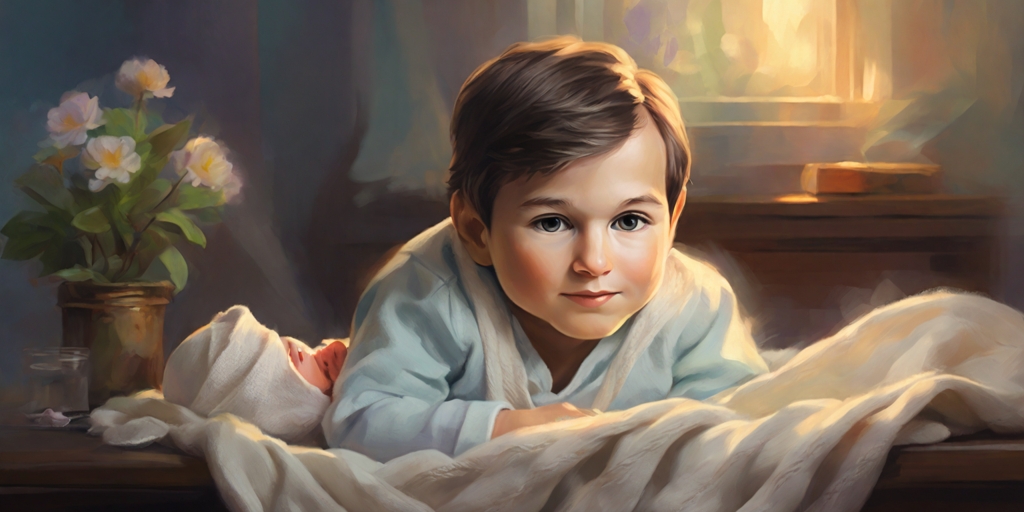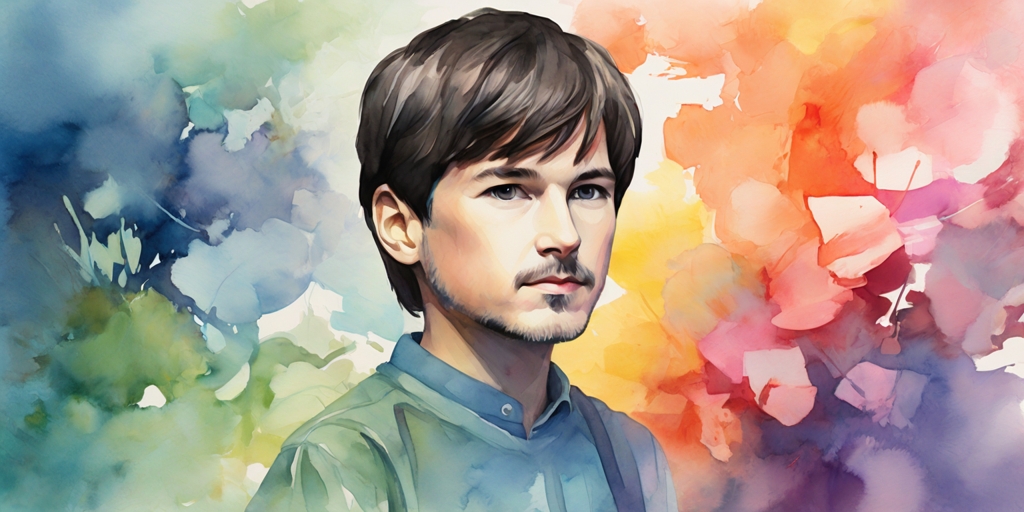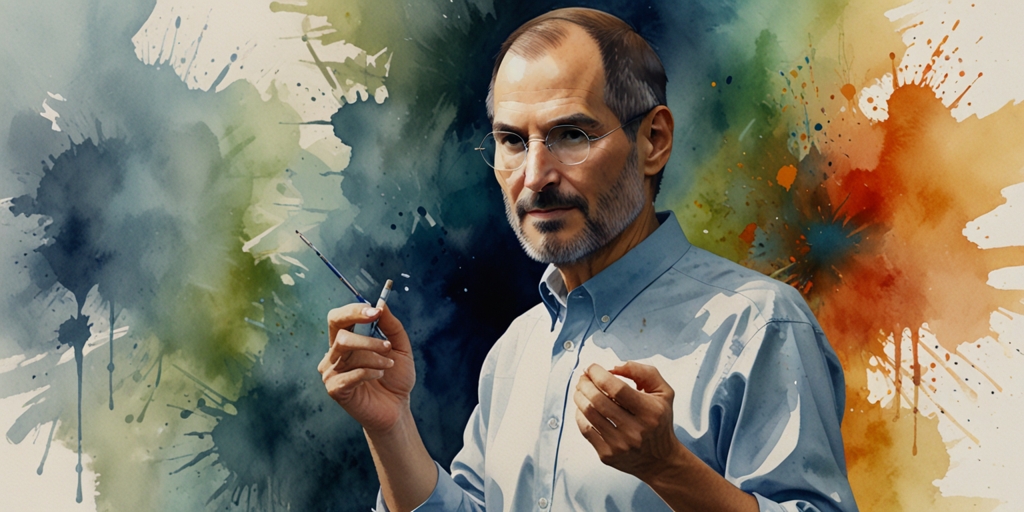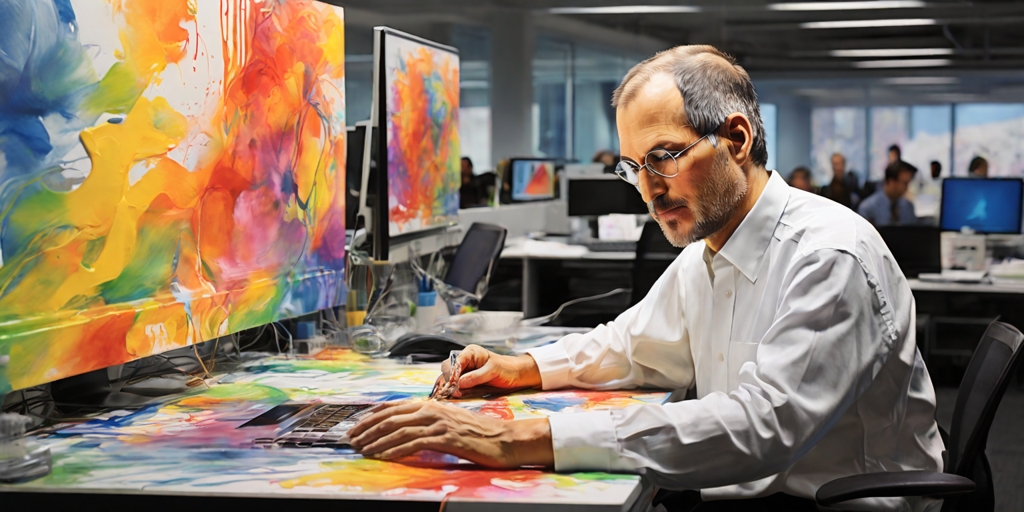Steve Jobs is a name that stands out in the world of technology. He co-founded Apple Inc. and showed us the power of never giving up. His story is about turning hard times into big wins. I’ve always been inspired by Steve Jobs’ life and legacy. His journey from humble beginnings to success is truly inspiring. It shows that with the right mindset, we can overcome any obstacle.
Let’s dive into Steve Jobs’ life and find out what made him so special. We’ll look at the moments that shaped his vision, his achievements, and how he stayed strong through tough times. Join us on this journey and learn from Steve Jobs’ life-changing lessons.

Steve Jobs Early Life and Adoption
Steve Jobs was born on February 24, 1955, in San Francisco to Joanne Schieble and Abdulfattah Jandali, who faced opposition from Schieble’s family due to cultural differences. As a result, Jobs was adopted by Paul and Clara Jobs, who promised to support his education despite not having college degrees themselves.
Jobs had a challenging early life, with Clara initially struggling to bond with him, but over time, he developed a strong relationship with his adoptive parents, whom he considered his true family. He was deeply loved and encouraged, although he acknowledged the complexities of his adoption later in life
Paul Jobs, a machinist, shared his love of mechanics with Steve by building a workbench in their garage. Steve admired his father’s craftsmanship and valued the time they spent working together
Steve Jobs struggled in traditional school settings, often resisting authority, misbehaving, and playing pranks. His father, Paul Jobs, who had faced abuse in his own childhood, never scolded Steve but blamed the school for not recognizing his potential. Jobs skipped 5th grade but became socially isolated in middle school, where bullying led him to threaten his parents with dropping out unless they transferred him to a different school.
In 1967, the family used all their savings to move to a new home in Los Altos, placing Steve in the Cupertino School District. This home later became the first site of Apple Computer. At 2013, Jobs boldly reached out to Bill Hewlett of Hewlett-Packard for parts for a project, landing a summer job that exposed him to the world of electronics—a pivotal moment in shaping his future.

Steve Jobs During High School
During his time at Homestead High School, Steve Jobs’ unique path began to take shape. The move to Los Altos gave him access to Homestead, which had strong ties to Silicon Valley. It was there that Bill Fernandez introduced him to Steve Wozniak, marking the start of their lifelong friendship and collaboration. Although Jobs enrolled in electronics classes, his rebellious nature led him to drift away from formal education, instead developing dual interests in technology and literature. His passion for music, Shakespeare, and unconventional experiences like snowshoeing trips reflected his growing individuality.
In 1971, Jobs and Wozniak’s collaboration bore fruit with the creation of the “blue box”, a device that allowed free long-distance phone calls. Selling these illegal devices showed Jobs the thrill of entrepreneurship and planted the idea that small players could disrupt big industries—a lesson that later fueled the creation of Apple. This experience, combined with his exploration of counter cultural practices like experimenting with LSD, shaped his worldview and set the foundation for his approach to innovation and business.

College Dropout and Calligraphy Class
In September 1972, Steve Jobs enrolled at Reed College in Portland, Oregon. Even though the school was expensive, and his parents, Paul and Clara, could barely afford it, Jobs insisted on applying only there. At Reed, he became friends with Robert Friedland, the student body president at the time. Chrisann Brennan, his girlfriend, also stayed connected with him during this period.
Jobs later shared that he was drawn to Eastern mysticism, which was becoming popular then. Reed College attracted many thinkers, including people like Timothy Leary, Richard Alpert, and Gary Snyder. There were constant conversations about the deeper meaning of life, and books like Be Here Now and Diet for a Small Planet were widely read by students.
Steve Jobs’ choice to leave college was unusual, but it led to his huge success. After one semester, Jobs dropped out of Reed without informing his parents. He later explained that he didn’t want to waste their money on education that didn’t feel meaningful to him. Even after leaving, he continued to attend classes informally, including a calligraphy course taught by Robert Palladino. This class taught Jobs about typography, making him love details and design. He became interested in font styles, spacing, and looks. These interests shaped Apple’s products and user experience.
In a 2005 speech at Stanford University, Jobs reflected on how he lived simply during this time—sleeping on floors in friends’ dorm rooms, collecting Coke bottles for money, and eating free meals at the local Hare Krishna temple. He credited the calligraphy class he took as a big influence on the Macintosh computer, saying that it inspired the use of multiple fonts and proportional spacing.
Jobs said, “If I had never dropped in on that single calligraphy course in college, the Mac would have never had multiple typefaces or proportionally spaced fonts.” This experience in design was key to his success, driving his quest for perfection.

Pre Apple 1974 – 1976
In February 1974, Steve Jobs went back to his parents’ home in Los Altos and started looking for a job. He quickly got hired by Atari, Inc. in Los Gatos, California, as a computer technician. Back in 1973, his friend Steve Wozniak had created a version of the video game Pong and gave the electronics board to Jobs. Atari hired Jobs because they thought he built it himself. Nolan Bushnell, Atari’s co-founder, described Jobs as “difficult but valuable” and noted he was often the smartest person in the room.
In mid-1974, Jobs traveled to India with his friend Daniel Kottke to seek spiritual teachings. They visited Neem Karoli Baba’s ashram but found it nearly empty because he had died in 1973. They then hiked to another ashram. After seven months in India, Jobs returned to the U.S. with a shaved head and traditional clothing. During this time, he experimented with psychedelics, which he later called one of the most important experiences of his life. He also practiced Zen Buddhism, attending retreats at a Zen monastery and considering a monastic life in Japan.
Jobs returned to Atari in early 1975, where he was tasked with creating a circuit board for the arcade game Breakout. He recruited Wozniak to help minimize the number of chips used. Wozniak succeeded in reducing the chip count significantly, surprising Atari engineers. However, Jobs later told Wozniak they were paid much less than they actually were.
In 1975, both Jobs and Wozniak attended meetings of the Homebrew Computer Club, which helped lead to the creation of the first Apple computer. Jobs also had a run-in with the law that year when he was arrested in Eugene, Oregon, for being a minor in possession of alcohol, but he claimed he didn’t have any. He ended up paying a fine for an outstanding speeding ticket instead.
Jobs grew up curious and determined. He loved to learn and ask questions. This curiosity was the start of his success in the tech world.
“The only way to do great work is to love what you do. If you haven’t found it yet, keep looking. Don’t settle.”

Steve Jobs at Apple 1976 – 1985
By March 1976, Steve Wozniak completed the design of the Apple I computer, which he showed to Steve Jobs. Initially hesitant about selling it, Wozniak eventually agreed. On April 1, 1976, Jobs, Wozniak, and Ronald Wayne founded Apple Computer Company at Jobs’s parents’ home. Their operation began in a bedroom and soon moved to a garage, with Wayne leaving shortly after.
The name “Apple” came from Jobs’s visit to an apple orchard in Oregon. They initially planned to sell bare circuit boards to hobbyists for $50 each, funding their first batch by selling personal items. They later secured a deal with computer retailer Paul Terrell to sell fully assembled units. By the end of that year, they had produced about 200 Apple I computers.
Steve Jobs started Apple because he loved new ideas. He wanted to make products that were both useful and beautiful. He aimed to break new ground in technology.
In April 1977, Apple introduced the Apple II, designed primarily by Wozniak. It became one of the first successful mass-produced microcomputers, despite initial challenges with its performance.
“The people who are crazy enough to think they can change the world are the ones who do.” This highlights his belief in the power of bold thinking and the impact of visionaries.

Ousted from Apple: A Humbling Setback
Steve Jobs, a visionary entrepreneur, faced many challenges. One key moment was when he was unexpectedly kicked out of Apple, the company he co-founded. Jobs’s ambition for Apple often clashed with that of CEO John Sculley, leading to a divide within the company. By 1985. This setback, though tough, helped him find his purpose again and grow stronger.
Motivational story
One of the most inspirational stories about Steve Jobs revolves around his journey of perseverance and resilience following his departure from Apple in 1985. After being ousted from the company he co-founded, Jobs faced a critical turning point in his life. Instead of succumbing to despair, he took the opportunity to reinvent himself. He founded NeXT, a computer platform development company, where he focused on creating high-quality, innovative products. Though NeXT initially struggled, Jobs persisted, emphasizing design and functionality, which later laid the groundwork for future successes.
His most significant triumph came when Apple acquired NeXT in 1997, bringing Jobs back to the company he had helped establish. This return marked the beginning of a new era for Apple. Under his leadership, the company introduced groundbreaking products such as the iMac, iPod, iPhone, and iPad, which transformed the tech landscape. Jobs’ story teaches us the importance of resilience, the power of innovation, and the ability to turn setbacks into opportunities
“Stay hungry, stay foolish.” This quote, which he used in his 2005 Stanford commencement speech, encourages continuous learning and the pursuit of one’s dreams without fear of failure.

Founding NeXT: Embracing Innovation
After leaving Apple in 1985, Steve Jobs started NeXT Inc. with $7 million. Facing financial difficulties the next year, he sought investment and caught the interest of billionaire Ross Perot. NeXT was launched in a high-profile event in San Francisco on October 12, 1988, which was seen as Jobs’s comeback.
The NeXT workstations debuted in 1990 at a price of $9,999, targeting the education sector but considered too expensive for many. They featured advanced technology, including an object-oriented software system, and were marketed to the financial and academic fields. Tim Berners-Lee used a NeXT computer to invent the World Wide Web in 1990.
Jobs later introduced the NeXTcube, which he called the first “interpersonal” computer, enabling multimedia email. However, due to high production costs, NeXT shifted to software development in 1993, eventually making its first profit in 1994. NeXT was acquired by Apple in 1997, and its software, including WebObjects, helped launch services like the Apple Store and iTunes.
“Innovation distinguishes between a leader and a follower.” Jobs believed that true leadership comes from the ability to innovate and think differently.

Pixar and Disney
In 1986, Steve Jobs invested $10 million to spin off The Graphics Group, later known as Pixar, from Lucasfilm. The first film produced with Disney, Toy Story (1995), was a huge success, credited to Jobs as executive producer. Under John Lasseter, Pixar created several hits, including Finding Nemo and The Incredibles, many of which won Academy Awards for Best Animated Feature.
In 2003-2004, Jobs and Disney’s Michael Eisner failed to renew their partnership, leading Jobs to announce he would not work with Disney again. However, when Bob Iger replaced Eisner in 2005, he rebuilt the relationship, resulting in Disney buying Pixar for $7.4 billion in 2006. This made Jobs Disney’s largest individual shareholder with 7% of the stock.
“I’m convinced that about half of what separates the successful entrepreneurs from the non-successful ones is pure perseverance.” Here, Jobs underscores the importance of resilience in achieving success.

Rejoining Apple: Reinventing the Company
In 1996, Apple was struggling, and its future relied on its next operating system. After failing to buy Be Inc., Apple reached a $400 million deal with NeXT in December. This brought Steve Jobs back to the company he co-founded, and he became the de facto chief after CEO Gil Amelio was ousted in July 1997. Jobs was officially named interim CEO on September 16.
To focus on profitability, Jobs cut several projects, which created fear among employees about job security. He also made it too expensive for other manufacturers to produce Macintosh clones. With NeXT’s technology, especially NeXTSTEP, Apple developed Mac OS X. Under Jobs, Apple saw a significant increase in sales with new products like the iMac. In 2000, Jobs dropped the “interim” from his title and became the permanent CEO, humorously calling himself “iCEO.” He wanted to make it a leader in tech again. His story shows his strength, vision, and drive for the best.
Apple expanded its product range by launching new digital devices. The iPod, a portable music player, along with iTunes software and the iTunes Store, marked Apple’s entry into consumer electronics and music distribution. On June 29, 2007, Apple released the iPhone, a revolutionary mobile phone with a multi-touch screen that combined the features of an iPod and introduced mobile browsing. Throughout this period, Steve Jobs encouraged his team to focus on bringing their ideas to market, reminding them that “real artists ship.”
“I’m not a businessman. I’m a business artist.” This reflects his view that business should be approached with creativity and artistry, merging innovation with entrepreneurial spirit.

Rediscovering Purpose and Resilience
Being kicked out of Apple was a humbling time for Steve Jobs. Instead of letting it beat him down, he used it to grow and learn. After leaving Apple, Jobs started a journey to find his true passion and purpose.
With a new determination, Jobs refused to let his failures define him. He saw this setback as a chance to reinvent himself and eventually return to Apple. Through this, he learned the value of resilience and perseverance.
“Sometimes life hits you in the head with a brick. Don’t lose faith.” This quote highlights the importance of resilience in the face of challenges and setbacks.
About Products
Steve Jobs is renowned for his role in shaping innovative products that transformed entire industries and changed the way we interact with technology. From the inception of the Apple I and Apple II, which brought personal computing to the masses, to the revolutionary Macintosh that introduced the graphical user interface, Jobs consistently pushed the boundaries of what technology could achieve. His tenure at Apple saw the launch of groundbreaking devices like the iPod, which redefined music consumption, and the iPhone, which not only changed the smartphone landscape but also integrated various technologies into a single device. Each product was marked by a strong emphasis on design, usability, and customer experience, which became hallmarks of the Apple brand.
Moreover, Jobs’s vision extended beyond hardware to software innovations such as iTunes, which transformed the music industry by providing a platform for digital purchases and music management. His involvement with NeXT laid the groundwork for modern macOS, showcasing his foresight in software development. The iPad further expanded Apple’s influence into the tablet market, while the Apple Watch and Apple TV continued to evolve under the ethos he established, blending technology with lifestyle. Jobs’s legacy is defined by his ability to create products that not only met consumer needs but also inspired loyalty and a unique cultural identity around the Apple brandsights on Steve Jobs’s products and impact
“I think the biggest innovations of the twenty-first century will be at the intersection of biology and technology.” Jobs expressed his belief in the transformative potential of integrating technology with human experience.

| Product Name | Launch Date | Age at Launch | Description |
| Apple I | 1976 | 21 years | The first personal computer by Apple, featuring a single-board design. |
| Apple II | 1977 | 22 years | One of the earliest mass-produced microcomputers, known for its open architecture. |
| Macintosh | 1984 | 29 years | The first successful personal computer with a graphical user interface (GUI) and a mouse. |
| Pixar | 1986 | 31 years | Jobs acquired the computer graphics division of Lucasfilm, leading to successful animated films. |
| NeXT Computer | 1989 | 34 years | A workstation for education and business, known for advanced software capabilities. |
| iMac | 1998 | 43 years | An all-in-one desktop focusing on design and simplicity. |
| iPod | 2001 | 46 years | A portable media player that revolutionized music by allowing users to carry thousands of songs. |
| iTunes | 2001 | 46 years | Software for organizing and purchasing music digitally. |
| Apple TV | 2007 | 52 years | A streaming device allowing users to watch content from various platforms. |
| iPhone | 2007 | 52 years | A smartphone integrating phone, iPod, and internet features, transforming mobile communication. |
| MacBook Air | 2008 | 53 years | A sleek, ultra-thin laptop focusing on portability. |
| iPad | 2010 | 55 years | A tablet computer focused on media consumption, creating a new category of devices. |

Steve Jobs Officially Resigns as Apple CEO
On January 17, 2011, Apple announced that Steve Jobs would take another medical leave, about a year and a half after his return following a liver transplant. Jobs shared the news in a letter to employees, saying he needed to focus on his health. As with his previous leave in 2009, Apple assigned Tim Cook to manage daily operations, though Jobs stayed involved in major company decisions. During his leave, Jobs made appearances at important events, including the iPad 2 launch on March 2, the WWDC keynote introducing iCloud on June 6, and a Cupertino City Council meeting on June 7.
On August 24, 2011, Jobs stepped down as Apple’s CEO. In his resignation letter to the board, he expressed that if the day ever came when he could no longer meet the expectations of the role, he would let them know—and sadly, that day had come. Jobs became the chairman of Apple’s board and named Tim Cook as his successor. He remained actively involved with the company until the day before his death, just six weeks after his resignation.

Honors and awards
| Year | Award/Honor | Description |
| 1985 | National Medal of Technology | Awarded for his contributions to the development of personal computing and technology. |
| 1991 | Entrepreneur of the Year | Recognized by Inc. magazine for his innovative approach to business and product development. |
| 1997 | Time 100 Most Influential People | Named one of the 100 most influential people in the world by Time magazine. |
| 2001 | Grammy Trustees Award | Honored for his contributions to the music industry, particularly with the launch of iTunes. |
| 2004 | Bay Area Business Hall of Fame | Inducted for his significant impact on the business landscape of the Bay Area. |
| 2010 | Fortune’s Most Powerful People in Business | Listed among the most powerful people in business by Fortune magazine. |
| 2011 | Jefferson Award for Public Service | Recognized for his significant contributions to society through innovation and technology. |
| 2011 | Grammy Award for Best Music Video | Awarded posthumously for the music video of “We Are the World,” in which he played a key role. |
| 2012 | Presidential Medal of Freedom | Awarded posthumously by President Barack Obama for his contributions to technology and innovation. |
“Design is not just what it looks like and feels like. Design is how it works.” This quote reflects his commitment to functional and user-centered design in technology.

The Final Chapter: Reflecting on the Life and Death
Steve Jobs passed away on October 5, 2011, after a long battle with pancreatic cancer. His death was a profound loss to the tech industry and the world, as he was a visionary who transformed how we interact with technology. In his final years, Jobs demonstrated remarkable courage and resilience, continuing to work on Apple products even while dealing with the challenges of his illness. His commitment to his craft and belief in the power of innovation serve as a powerful reminder of the impact one individual can have on the world.
Jobs’ life and legacy offer invaluable lessons in perseverance and the pursuit of one’s passions. He famously encouraged others to “live each day as if it were your last,” reminding us that time is our most precious resource. His journey exemplifies that setbacks, challenges, and even death can drive us to create, innovate, and live authentically. As readers reflect on Jobs’ story, they are inspired to pursue their own dreams with vigor and resilience, understanding that life’s challenges can lead to profound personal growth and achievement
“Your time is limited, so don’t waste it living someone else’s life.” This quote emphasizes the importance of pursuing one’s own passions and not conforming to societal expectations.
Key Takeaways
- Resilience and determination can transform adversity into success
- Passion and vision are the driving forces behind innovation
- Embracing failures and learning from them is essential for growth
- Continuous reinvention and pursuit of excellence are key to longevity
- Inspiring others and leaving a lasting legacy are the hallmarks of true greatness
We want to hear from you! Which aspect of Steve Jobs’ journey resonated with you the most? Are there other influential figures or business leaders you’d like us to explore in future blogs? If you’ve faced challenges similar to those described, we’d love to hear your story. Your feedback helps us create content that truly interests you!
Note
This article is intended for informational and educational purposes only. The content is based on publicly available information, including sources like news articles, biographies, and interviews, wikipedia (https://en.wikipedia.org/wiki/Steve_Jobs). While every effort has been made to ensure accuracy, we do not guarantee that the information is completely free from errors.
“Explore our other insightful categories like Inspiration and Innovation to discover more about the journeys of great visionaries like Steve Jobs.”
“Check out our sections on Business Success and Tech Legends for more stories that highlight resilience and creativity in the face of challenges.”
